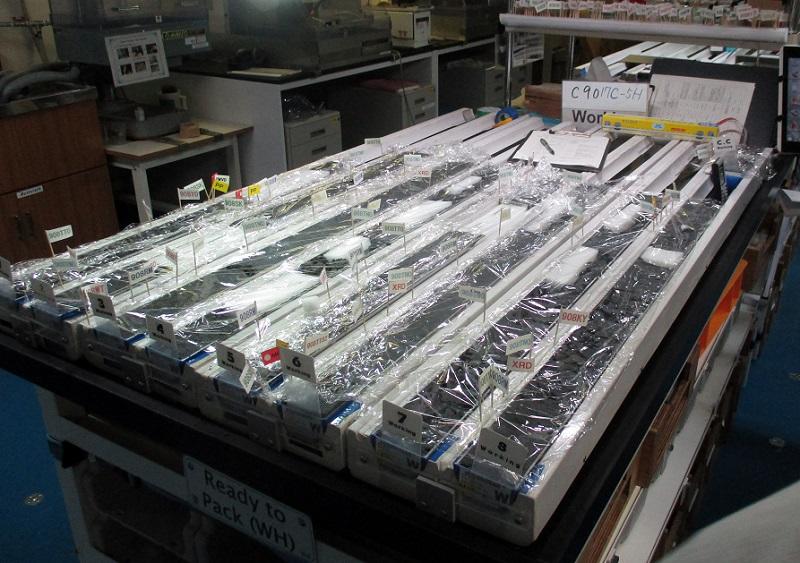Bulletin of the Geological Survey of Japan Top Page
Bulletin of the Geological Survey of Japan Vol.69 No.6 (2018)
Cover photograph | Table of Contents | Abstract
Cover photograph
Sub-seafloor core samples drilled from the Iheya Minor Ridge area, Middle Okinawa Trough
Core samples are stored on the core table in the D/V Chikyu during the CK16-01 (Exp. 908) cruise in the Cross-ministerial Strategic Innovation Promotion Program (SIP), “Next-generation technology for ocean resources exploration” . In general, the cores are pulled up on the deck in the length of about 9.5 m, cut into one-meter-long sections, and provided for whole-round measurements. Then they are split vertically for visual core description. The split cores are further cut into discrete samples for on-board analyses and post-cruise researches. The flags beside the cores denote the position where the analysis samples were obtained.
(Photograph and Caption by Toru Yamasaki)
Table of Contents
All the pages PDF : 69_06_full.pdf [11MB]
| Title | Author | |
|---|---|---|
| Note and comment | ||
| Scientific research on formation processes of ocean resources: GSJ’s research results of the Cross-ministerial Strategic Innovation Promotion Program (SIP), “Next-generation technology for ocean resources exploration” |
Toru Yamasaki, Shogo Komori, Takahiko Inoue, Osamu Ishizuka and Ken Ikehara(p265-303)
|
69_06_01.pdf [9.3MB] |
Abstract
Scientific research on formation processes of ocean resources: GSJ’s research results of the Cross-ministerial Strategic Innovation Promotion Program (SIP), “Next-generation technology for ocean resources exploration”
Toru Yamasaki, Shogo Komori, Takahiko Inoue, Osamu Ishizuka and Ken Ikehara
The scientific research results of the Geological Survey of Japan (GSJ) from the five-year project of the Cross-ministerial Strategic Innovation Promotion Program (SIP), “Next-generation technology for ocean resources exploration” are summarized. GSJ has been involved in one of the four R&D themes, namely “Scientific research on formation processes of ocean resources” in collaboration with the Japan Agency for Marine-earth Science and Technology (JAMSTEC) and Kyushu University. GSJ’s research focused mainly on (1) tectono-magmatic evolution of basement geology, petrogenesis of igneous rocks and the relationship between magmatism and ore-formation, and (2) determination of scientific indices for marine surveys, narrowing down the potential areas based on investigations of geochemical and physical properties of igneous rocks, sediments and sulfides, as part of the research on genesis of seafloor massive sulfide deposits in Okinawa Trough. For (1), it was observed that, based on petrological and geochemical investigations of igneous rocks, mantle-derived mafic magma ascended to shallower portions of the crust and extruded on the seafloor due to thinning by back-arc rifting. These magmatic products were hydrothermally altered while the periodical ascent of mafic magma induced hydrous partial melting of altered basaltic rocks and production of felsic magma. These processes reasonably explain composition of extrusive rocks and formation of ore-fluid. In (2), new geochemical survey method for detecting the ore-related features were proposed, based on studies of felsic igneous rocks (pumices) widely distributed in the hydrothermal field, and electrical properties of subsea rocks, including sulfides, which contribute to the upgrading of the electromagnetic survey method, were disclosed from recovered cores by D/V Chikyu cruises. These results would save the effort for the first stage of surveys by narrowing down the potential areas and contribute towards developing more efficient surveys by determining optimal spec and acquisition data for next-generation technology for ocean resources exploration.
Geological Survey of Japan, AIST
- About GSJ
- Our Activities
- Purchase guide
-
Publications and Database
- information
- Bulletin of the Geological Survey of Japan
- bull2025(Vol.76)
- bull2024(Vol.75)
- bull2023(Vol.74)
- bull2022(Vol.73)
- bull2021(Vol.72)
- bull2020(Vol.71)
- bull2019(Vol.70)
- bull2018(Vol.69)
- bull2017(Vol.68)
- bull2016(Vol.67)
- bull2015(Vol.66)
- bull2014(Vol.65)
- bull2013(Vol.64)
- bull2012(Vol.63)
- bull2011(Vol.62)
- bull2010(Vol.61)
- bull2009(Vol.60)
- bull2008(Vol.59)
- bull2007(Vol.58)
- bull2006(Vol.57)
- bull2005(Vol.56)
- bull2004(Vol.55)
- bull2003(Vol.54)
- bull2002(Vol.53)
- bull2001(Vol.52)
- Bulletin of the Geological Survey of Japan(old)
- Annual Report on Active Fault and Paleoearthquake Researches
- Reports, Geological Survey of Japan
- CCOP-GSJ Groundwater Project Report
- CCOP Technical Bulletin
- Cruise Report
- Geological Hazards
- Learning and Education
- GSJ Database Collection
- Collection of links


